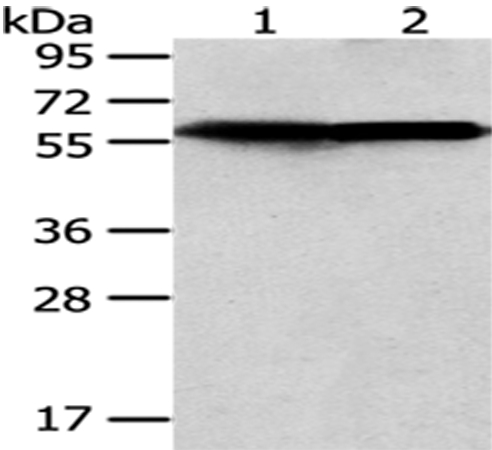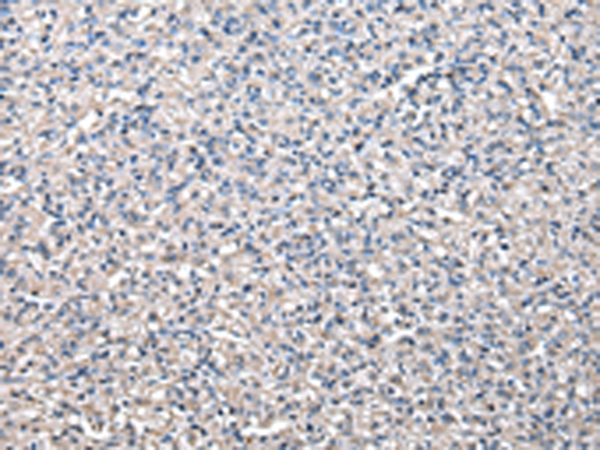

| WB | 咨询技术 | Human,Mouse,Rat |
| IF | 咨询技术 | Human,Mouse,Rat |
| IHC | 1/20-1/100 | Human,Mouse,Rat |
| ICC | 技术咨询 | Human,Mouse,Rat |
| FCM | 咨询技术 | Human,Mouse,Rat |
| Elisa | 咨询技术 | Human,Mouse,Rat |
| Aliases | CCTE; HEL-S-69; CCT-epsilon; TCP-1-epsilon |
| Entrez GeneID | 22948; |
| WB Predicted band size | 60kDa |
| Host/Isotype | Rabbit IgG |
| Antibody Type | Primary antibody |
| Storage | Store at 4°C short term. Aliquot and store at -20°C long term. Avoid freeze/thaw cycles. |
| Species Reactivity | Human,Mouse |
| Immunogen | Fusion protein of human CCT5 |
| Formulation | Purified antibody in PBS with 0.05% sodium azide. |
+ +
以下是关于CCT5抗体的3篇参考文献示例(注:文献为示例性概括,具体内容请通过学术数据库核实):
---
1. **文献名称**: *CCT5 regulates cell proliferation and apoptosis in colorectal cancer via modulation of the ERK signaling pathway*
**作者**: Zhang L, et al.
**摘要**: 本研究通过Western blot和免疫组化技术,利用CCT5抗体检测其在结直肠癌组织中的表达,发现CCT5高表达与患者不良预后相关,并证实其通过调控ERK信号通路促进肿瘤细胞增殖。
2. **文献名称**: *The role of CCT5 in maintaining proteostasis in neurodegenerative disease models*
**作者**: Smith J, et al.
**摘要**: 该研究使用CCT5抗体进行免疫荧光染色,发现CCT5在阿尔茨海默病模型神经元中与错误折叠蛋白共定位,提示其在蛋白质稳态中的作用可能影响疾病进展。
3. **文献名称**: *Structural insights into the CCT complex assembly using subunit-specific antibodies*
**作者**: Tanaka K, et al.
**摘要**: 通过CCT5抗体的免疫共沉淀实验,揭示了CCT复合体各亚基间的相互作用机制,为理解伴侣蛋白复合体的组装和功能提供了新视角。
---
如需获取具体文献,建议在PubMed、Web of Science或Google Scholar中搜索关键词“CCT5 antibody”或结合研究领域(如癌症、神经生物学)进一步筛选。
The CCT5 antibody targets the fifth subunit of the chaperonin-containing TCP-1 (CCT) complex, a conserved eukaryotic molecular chaperone critical for folding cytoskeletal proteins like actin and tubulin. The CCT complex, composed of eight distinct subunits (CCT1-8), forms a double-ring structure that assists in ATP-dependent protein folding. CCT5 (also called CCTε) plays a vital role in maintaining structural integrity and functional coordination within the complex. Dysregulation of CCT5 has been linked to neurodegenerative disorders, cancer, and developmental defects, highlighting its importance in cellular homeostasis.
CCT5 antibodies are widely used in research to study protein folding mechanisms, subunit-specific interactions, and the complex’s role in diseases. They enable detection of CCT5 expression via techniques like Western blotting, immunofluorescence, and immunoprecipitation, helping to map its tissue distribution and subcellular localization. Additionally, these antibodies aid in investigating post-translational modifications or mutations affecting CCT5 function. Recent studies have utilized CCT5 antibodies to explore its involvement in pathologies such as Alzheimer’s disease, where misfolded proteins accumulate, and in cancers characterized by cytoskeletal instability. The development of high-specificity CCT5 antibodies continues to advance understanding of chaperonin biology and therapeutic targeting opportunities.
×